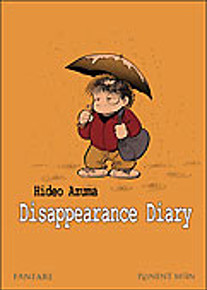Review
by Casey Brienza,Disappearance Diary
| Synopsis: |  |
||
Don't let anyone tell you that a life drawing manga is interesting! It's what mangaka do when they're not drawing manga, rather, that makes for the really dishy material. In the award-winning Disappearance Diary, veteran mangaka Hideo Azuma presents a series of autobiographical episodes detailing various—often humiliating—periods of his life. Azuma's checkered past includes stints as a bum dumpster diving for discarded scraps of food and cigarette butts and as a gas pipe layer. Though inordinately attached to his drink for many years, he eventually became an alcoholic suffering from hallucinations and was forced by his family into rehab. Despite the genuinely horrific nature of many of these tales, all are recounted in a light-hearted, cartoony style. |
|||
| Review: | |||
I don't know how we got it into our heads that tragedies are better than comedies or that misery is a more noble literary endeavor than mischief...we're just kidding ourselves. Humor is hard—indeed, one the most underrated of creative skills—and those writers of quality who truly have the knack for it are few and far between. Azuma Hideo, so-called “father of lolicon” who has had a long career churning out all manner of manga from shoujo to seinen, is clearly one of them. His sense of comic timing is impeccable, and the way he draws himself as a caricatured lump of a chain-smoking man who loses more of his hair with each successive chapter is endearing. The extent of the abjection depicted here is extreme, yet I actually found myself laughing till I cried. Best of all, I didn't have to feel guilty about taking pleasure in another's pain because Azuma makes it abundantly clear, right from the very first text box, that he wants this manga to be funny. And indeed, what is most remarkable about Disappearance Diary by far is the way in which the author has reached a point in his life where he can distance himself from the most trying times he's ever faced to arrive at that transcendent place where even attempted suicides and near death from hypothermia can become a resource with which to delight and entertain his readers. For despite the assured narrative and draftsmanship, writing this manga could not have been easy for him. In some ways, it's like a therapeutic exercise…especially since Azuma's wife, the one who actually had to deal directly with the consequences of all this bad behavior, also works as his assistant and drew this story right along with him. Or perhaps I should say “over” him instead, since she supposedly inked all of the pages. Either way, I greatly admire their bravery. The manga is divided into four discrete sections, each several chapters long. The first details Azuma's first stint as a hobo, the second his employment with a gas pipe sub-contractor, the third his early productive career as a mangaka, and the last his descent into alcoholism and subsequent rehabilitation. The chapter about his career as a mangaka is, unsurprisingly, the least compelling of the lot. After all, what's dealing with three editors at the same time when compared to living on the streets or in a psychiatric ward? Interestingly, the panel layouts and stylized artwork of each chapter resemble long-running American newspaper strips such as Garfield and Beetle Bailey more than they do contemporary mainstream manga such as Naruto. As such, readers who do not ordinarily enjoy manga should find Disappearance Diary to be quite accessible. The Fanfare edition is attractively produced with original art flipped to read left to right. An extensive and informative interview with is included at the end of the book. Creamy paper and French flaps that unfold to uncover an additional “special confidential” interview with Azuma are welcome bonuses. Sound effects have been replaced with English, but those panels that have Japanese text in the artwork (street signs, etc.) appear not to have been reversed. I was a bit disappointed by the quality of the translation; certain cultural points are left unexplained and, more egregiously, certain comedic punch lines suffer from lackluster adaptation. (See, for example, the way the editor's letter to Azuma has been translated on page 6. Had it been up to me, I would have glossed it more liberally.) But guess what? Translating comedy is also harder than translating tragedy! In any case, this is the most impressive Fanfare / Ponent Mon co-production I have seen thus far, and I would heartily recommend it to anyone interested in mainstream manga publishing or the lives of Japanese mangaka. The author's candor is refreshing, not to mention a perhaps cautionary tale to any and all who might want the sort of life he's had. Manga creation ain't just a bed of roses! It's too bad that hardly anyone in the English-speaking world even knows who Azuma Hideo is or what he is otherwise famous for (though prior knowledge is not a prerequisite for thorough enjoyment of this manga). Fortunately, after reading Disappearance Diary, they will. |
| Grade: | |||
|
Overall : A
Story : A-
Art : A+
+ Assured, charismatic storytelling and art. Not to mention a "positive outlook on life" that gazes into the abyss...and laughs. |
|||
| discuss this in the forum (9 posts) | | |||
| Production Info: | ||
|
Full encyclopedia details about |
||